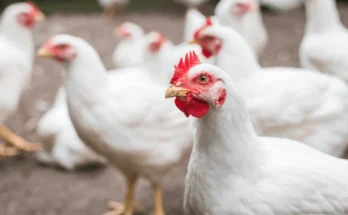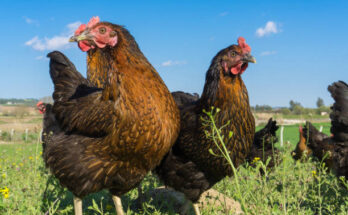Understanding Chicken Behavior: A Comprehensive Guide
Understanding chicken behavior is essential for anyone who raises or works with these birds. Chickens display a wide range of behaviors, from social interactions within the flock to foraging and nesting habits. By gaining insight into the behavior of chickens, you can better care for them and ensure their well-being. In this blog post, we’ll explore various aspects of chicken behavior, providing valuable knowledge for both new and experienced chicken owners.
Understanding Chicken Behavior
Understanding the chicken behavior is essential for raising them successfully. By delving into the social structure within chicken flocks and the unique communication methods employed by these fascinating birds, you can better cater to their needs and ensure their well-being.
Social Structure in Chicken Flocks
Chicken flocks are inherently hierarchical, with each bird distinctly aware of its place within the pecking order. This social structure plays a crucial role in minimizing conflicts and maintaining order within the flock. Typically, the dominant rooster and hen occupy the top positions, followed by subordinate individuals. Chicken behaviour if often reflected from their rank in the flock.
The pecking order determines access to resources such as food, water, and nesting areas. Understanding and respecting this hierarchy is vital in preventing aggressive behavior and promoting a harmonious environment within the flock.
Communication Among Chickens
Chickens have a sophisticated system of communication that involves various vocalizations, body language, and behaviors. They use different calls to alert others about the presence of predators, to signal the discovery of food, and to establish their territory. Being very territorial is a common chicken behaviour, and a form of communication amongst chickens.
Moreover, chickens convey a wide range of emotions through their vocalizations and body language, enabling them to express distress, contentment, and agitation. By observing and understanding these cues, you can gain valuable insights into your chickens’ well-being and address any potential issues promptly.
By comprehending the social dynamics and communication methods of chickens, you can foster a conducive environment that promotes their natural behavior and overall welfare.
Recognizing Signs of Contentment
When chickens are content, they exhibit relaxed body language. Their feathers are smooth, and they may softly cluck or purr. Additionally, they will often engage in dust bathing, where they vigorously fluff up the soil and roll around in it.
Identifying Signs of Distress
Distressed chickens display different body language cues. They may huddle together, tuck their heads in, or exhibit rapid and erratic movements. Feather pecking and excessive vocalization are also indicators of distress. Paying attention to these signs can help you address any underlying issues promptly. You will quite commonly see unusual chicken behaviour patterns when under distress.
Understanding and interpreting chicken body language is an essential skill for any chicken owner. By recognizing signs of contentment and distress, you can ensure the well-being of your flock and address any issues that may arise.
Natural Chicken Behaviour
Foraging and Scratching
Chickens are natural foragers, spending a significant part of their day searching for insects, seeds, and plants. This behavior is deeply ingrained in their DNA as they scratch and peck at the ground, using their beaks and claws to uncover hidden treasures. Foraging not only provides essential nutrition but also enables chickens to exhibit their natural instincts, promoting their overall well-being and contentment.
Dust Bathing
One of the most fascinating behaviors of chickens is their dust bathing ritual. They instinctively find a dry patch of soil, fluff up their feathers, and vigorously wriggle and roll around in the dust. This seemingly peculiar activity serves a crucial purpose, helping chickens to rid themselves of parasites and excess oils while also providing a form of relaxation. Observing chickens engage in dust bathing is akin to witnessing a rejuvenating spa session, highlighting the quirky yet essential nature of their behavior. Dust bathing is normal chicken behaviour, however in unventilated spaces too often, can cause respiratory issues
Egg-Laying Behavior
Nesting Behavior
When it comes to egg-laying behavior, chickens exhibit distinct nesting behaviors. They prefer secluded and comfortable spots for laying eggs. Providing nesting boxes filled with clean and soft bedding material can encourage hens to lay eggs in a designated area, promoting cleanliness and ease of egg collection.
Broodiness in Hens
Broodiness in hens refers to their natural instinct to incubate eggs and rear chicks. This behavior is marked by the hen’s dedication to sitting on a clutch of eggs, often resulting in decreased egg production. While broodiness was valuable for natural reproduction in the wild, it can pose challenges for egg production in a domestic setting. Some chicken breeds are more prone to broodiness than others, and managing broody hens involves strategies to discourage excessive broodiness and maintain consistent egg production levels.
Aggressive Behavior in Chickens
Aggressive chicken behaviour can be a cause of concern for poultry farmers, as it can lead to injuries and decreased egg production. Understanding the causes of aggression and implementing effective management strategies is crucial in maintaining a harmonious flock.
Causes of Aggression
- Pecking Order: Chickens establish a social hierarchy within the flock, and aggressive behavior often stems from dominance disputes. Lower-ranking birds may exhibit aggression in an attempt to rise in the pecking order.
- Overcrowding: Limited space can lead to increased aggression as chickens compete for resources such as food, water, and roosting areas. This can result in heightened stress levels and aggressive interactions.
- Lack of Environmental Enrichment: Boredom and frustration can contribute to aggressive behavior. Without opportunities for natural behaviors such as pecking, scratching, and dust bathing, chickens may redirect their energy towards aggression.
- Broodiness: Hens can become fiercely protective of their nests when broody, exhibiting aggressive behavior towards any perceived threats, including other flock members.
Managing Aggressive Behavior
- Provide Adequate Space: Ensuring sufficient space per bird can help alleviate aggression stemming from overcrowding. Aim for at least 4 square feet of space per chicken within the coop.
- Environmental Enrichment: Encourage natural behaviors by providing enriching elements such as perches, dust bathing areas, and hanging treats to alleviate boredom and reduce aggression.
- Multiple Feeding and Watering Stations: Distributing feeding and watering stations throughout the coop can prevent resource guarding and reduce competition among chickens.
- Observation and Intervention: Regularly monitor the flock for signs of aggression, and intervene by separating particularly aggressive birds or providing distractions to diffuse tense situations.
Understanding the underlying causes of aggression in chickens and implementing proactive management strategies is fundamental in promoting a peaceful and productive flock.
Environmental Factors Affecting Behavior
Impact of Space and Housing
When it comes to chicken behavior, the impact of space and housing is a significant factor. The amount of space available to chickens directly influences their behavior. In crowded or confined spaces, chickens may exhibit aggressive behavior, such as pecking and fighting. Additionally, inadequate space can lead to stress and decreased overall well-being, impacting egg production and growth rates.
Influence of Lighting on Behavior
Lighting plays a crucial role in shaping chicken behavior. The intensity and duration of light exposure can affect their daily routines and physiological functions. Chickens require sufficient light for feeding, drinking, and social interactions. Inadequate lighting can disrupt their circadian rhythm, leading to irregular patterns of activity and rest. On the same note, overly bright lighting can cause distress and discomfort, negatively impacting their behavior and welfare.
Quite often chicken behaviour can be influenced by their health, and we recommend you check this article for preventing harmful diseases.
Conclusion
Understanding chicken behavior is essential for any poultry farmer or enthusiast. By recognizing the natural instincts and social dynamics of chickens, one can better care for their well-being and foster a productive environment. Implementing suitable housing, providing enriching activities, and maintaining a balanced diet are all influenced by an understanding of chicken behavior. By observing and adapting to their behavior, you can ensure the health and happiness of your flock, leading to better egg production and overall success in poultry farming. Hopefully you have a strong insight into chicken behaviour and what to expect!



